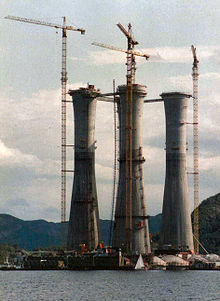User:Syrian Eng/sandbox
- This article is about pouring concrete in moving forms. See Slipform stonemasonry for another type of slip forming, and Slipcasting for manufacture of ceramic vessels.
Slip forming, continuous poured, continuously formed, or slipform construction is a construction method in which concrete is poured into a continuously moving form.[1] Slip forming is used for tall structures (such as bridges, towers, buildings, and dams), as well as horizontal structures, such as roadways. Slipforming enables continuous, non-interrupted, cast-in-place "flawless" (i.e. no joints) concrete structures which have superior performance characteristics to piecewise construction using discrete form elements. Slip forming relies on the quick-setting properties of concrete, and requires a balance between quick-setting capacity and workability. Concrete needs to be workable enough to be placed into the form and consolidated (via vibration), yet quick-setting enough to emerge from the form with strength. This strength is needed because the freshly set concrete must not only permit the form to "slip" by the concrete without disturbing it, but also support the pressure of the new concrete as well as resist collapse caused by the vibration of the compaction machinery.


In vertical slip forming the concrete form may be surrounded by a platform on which workers stand, placing steel reinforcing rods into the concrete and ensuring a smooth pour.[2] Together, the concrete form and working platform are raised by means of hydraulic jacks.[3] Generally, the slipform rises at a rate which permits the concrete to harden by the time it emerges from the bottom of the form.[1]
In horizontal slip forming for pavement and traffic separation walls concrete is laid down, vibrated, worked, and settled in place while the form itself slowly moves ahead. This method was initially devised and utilized in Interstate Highway construction initiated by the Eisenhower administration during the 1950s.

History
[edit]The slip forming technique was in use by the early 20th century for building silos and grain elevators. James MacDonald, of MacDonald Engineering of Chicago was the pioneer in utilizing slip form concrete for construction. His concept of placing circular bins in clusters was patented, with photographs and illustrations, contained in a 1907 book, “The Design Of Walls, Bins, And Grain Elevators”.[4]
In 1910, MacDonald published a paper “Moving Forms for Reinforced Concrete Storage Bins,” [5] describing the use of molds for moving forms, using jacks and concrete to form a continuous structure without joints or seams. This paper details the concept and procedure for creating slip form concrete structures. On May 24, 1917, a patent was issued to James MacDonald of Chicago, "for a device to move and elevate a concrete form in a vertical plane".[6]
James MacDonald’s bin and silo design was utilized around the world into the late 1970s by MacDonald Engineering. In the 1947-1950 period, MacDonald Engineering constructed over 40 concrete towers using the slip-form method for AT&T Long Lines[7] up to 191 ft tall for microwave relay stations across the United States.

The former LandMark Hotel/Casino in Las Vegas was constructed in 1961 by MacDonald Engineering as a subcontractor, utilizing Macdonald’s concept of slip form concrete construction to build the 31 story reinforced steel tower.[8]
The technique was introduced to residential and commercial buildings in the late 1960s.[2] One of Its first uses in high-rise buildings in the United States was on the shear wall supported apartment building at Turk & Eddy Streets in San Francisco, CA, in 1962, built by the San Francisco office of Macdonald Engineering. The first notable use of the method in a residential/retail business was the Skylon Tower in Niagara Falls, Ontario, which was completed in 1965. Another unusual structure was the tapered buttress structures for the Sheraton Waikiki Hotel in Honolulu, Hawaii, in 1969. Another shear wall supported structure was the Casa Del Mar Condominium on Key Biscayne, Miami, FL in 1970.
From the 1950s, the vertical technique was adapted to mining head frames, ventilation structures, below grade shaft lining, and coal train loading silos; theme and communication tower construction; high rise office building cores; shear wall supported apartment buildings; tapered stacks and hydro intake structures, etc. It is used for structures which would otherwise not be possible, such as the separate legs of the Troll A deep sea oil drilling platform which stands on the sea floor in water about 1000 feet (300 m) deep, has an overall height of 472 meters (1,549 ft), weighs 656,000 tons, and has the distinction of being the tallest structure ever moved (towed) by mankind.
In addition to the typical silos and shear walls and cores in buildings, the system is used for lining underground shafts and surge tanks in hydroelectric generating facilities. The technique was utilized to build the Inco Superstack in Sudbury, Ontario, and the CN Tower in Toronto. In 2010, the technique was used to build the core of the supertall Shard London Bridge tower in London, England.
References
[edit]- ^ a b Nawy, Concrete Construction Engineering Handbook, 2008, p. 10—33.
- ^ a b "'Slip Forming' Technique Introduced in Baltimore." Washington Post. May 1, 1971.
- ^ Nawy, Concrete Construction Engineering Handbook, 2008, p. 10—34.
- ^ “The Design Of Walls, Bins, And Grain Elevators”. By Milo Smith Ketchum, The Engineering News Publishing Co.,1907, page 294. [1]
- ^ James MacDonald - “Moving Forms for Reinforced Concrete Storage Bins.” Proceedings of the Seventh Annual Convention Held at N.Y., N.Y. Volume 7, By National Association of Cement Users (U.S.). December 12–20, 1910. page 554.[2]
- ^ Official gazette of the United States Patent Office, By United States. Patent Office Volume CCXXXVII. April 24, 1917, page 943.[3]
- ^ [4] The Concrete Microwave Towers of AT&T's First Transcontinental Radio Route>
- ^ Construction of tower for the LandMark Hotel/Casino, Las Vegas
External links
[edit]- Slip-Form Construction Time Lapse - The Dalles, Oregon Retrieved 2014-04-22.
- Slipform
- MacDonald Engineering's slip form concrete grain silos

Bibliography
[edit]- Nawy, Edward G. Concrete Construction Engineering Handbook. New York: CRC Press, 2008.

